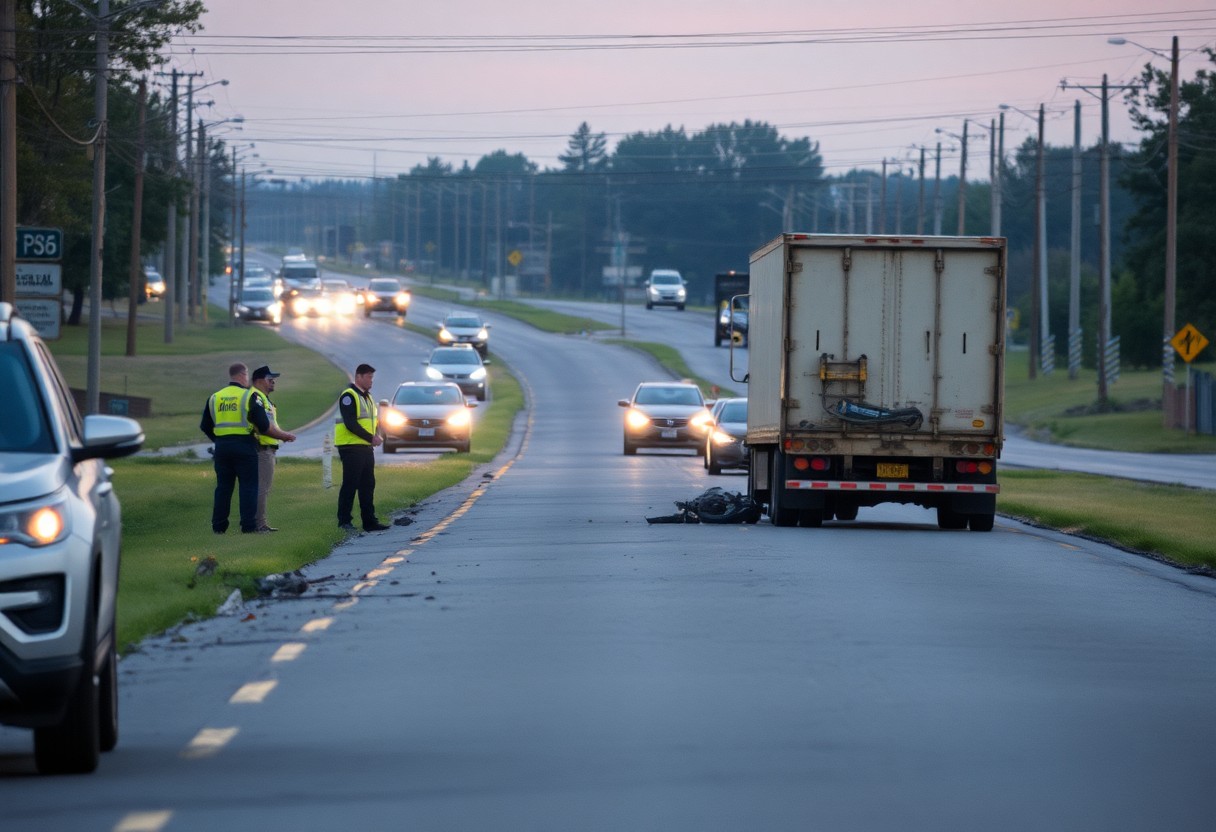Urban environments often present challenges when it comes to sharing the road with large trucks. With their size and weight, these vehicles can create blind spots and require longer stopping distances, making it important for you to stay alert. By understanding key strategies for safely navigating around these trucks, you can enhance your driving experience and contribute to a safer road environment. In this blog post, you will learn practical tips to effectively manage your interactions with large trucks in the busy streets of Mobile.
Understanding Large Trucks
Before navigating around large trucks in Mobile’s urban areas, it’s necessary to familiarize yourself with their unique characteristics. These vehicles are designed to transport heavy materials and goods, making them significantly different from standard automobiles. Their larger size and weight influence how they maneuver, stop, and respond to traffic conditions, which can pose challenges for nearby drivers. Understanding their operation will help you stay safe on the road.
Types of Large Trucks
To effectively navigate around large trucks, it’s important to know the common types you’ll encounter:
| Box Trucks | Used for transporting freight and goods. |
| Dump Trucks | Transport loose materials like sand and gravel. |
| Flatbed Trucks | Ideal for carrying oversized loads. |
| Tanker Trucks | Transport liquids such as fuel and chemicals. |
| 18-Wheelers | Large transport trucks often seen on highways. |
This knowledge can boost your confidence when driving in the vicinity of these vehicles.
Common Challenges in Urban Areas
If you’ve ever driven in urban areas, you might have noticed that large trucks can create unique challenges. Their size limits maneuverability, requiring careful navigation in tightly packed street conditions, especially during peak traffic times.
Another issue is their blind spots, which can extend significantly around the truck. This makes it crucial for you to maintain a safe distance when they are turning or changing lanes. Traffic congestion often exacerbates these challenges, as large trucks may take longer to stop or accelerate compared to smaller vehicles. Additionally, road conditions such as potholes and construction can further complicate their operations. By understanding these challenges, you can enhance your safety and successfully share the road with large trucks.
Factors to Consider When Navigating Around Trucks
While driving in Mobile’s urban areas, you must consider several factors when navigating around large trucks. Effective navigation ensures your safety and the safety of others on the road. Key points to keep in mind include:
- Truck Size
- Blind Spots
- Stopping Distances
- Turning Radius
Perceiving these factors adequately can help you avoid accidents and enhance road safety.
Size and Blind Spots
One significant factor you should consider is the size of trucks compared to your vehicle. Large trucks can weigh up to 80,000 pounds and have much larger dimensions than passenger vehicles. This size difference means they have extensive blind spots on all sides, particularly before and behind the vehicle. When you are driving near a truck, ensure you position your vehicle in a way that maintains visibility and avoids entering these dangerous zones. Always be cautious when changing lanes and merging.
Stopping Distances
Factors to understand about trucks also include their stopping distances, which are significantly longer than those of standard vehicles. Because of their weight and size, large trucks take much longer to come to a complete stop. As a rule of thumb, a fully loaded truck may require up to 400 feet to stop, depending on speed and road conditions. This translates to the necessity of maintaining a safe distance when behind a truck to prevent rear-end collisions in case of sudden stops.
A good practice is to always allow for additional stopping distance when near large trucks, especially in urban areas where traffic conditions may change abruptly. This means keeping your distance during braking and being aware of the road conditions. In scenarios with adverse weather or heavy traffic, increase your following distance even further, as trucks will take longer to stop. Adjust your speed and maintain a safe following distance to enhance your safety and that of others on the road.
Tips for Safe Navigation
Assuming you’re navigating around large trucks in Mobile’s urban areas, it’s crucial to prioritize safety. Keep these tips in mind for your journey:
- Always maintain a clear line of sight.
- Avoid blind spots around the truck.
- Stay alert to the truck’s movements.
- Use your signals well in advance.
- Be patient and allow for extra space.
After following these tips, you’ll significantly enhance your safety and that of others on the road.
Maintaining Adequate Distance
Now, maintaining adequate distance from large trucks is vital for your safety. Keeping a safe space provides you with enough time to react to sudden stops or changes in the truck’s path. Aim for a distance of at least three car lengths, especially when driving behind a truck, to improve your visibility and reaction time.
Signaling and Communication
Now, signaling and communication with large trucks are crucial for safe navigation. Always use your turn signals well in advance and utilize your horn sparingly to alert the truck driver of your presence. This helps to ensure that both you and the truck driver are on the same page about your intentions, reducing the chances of miscommunication.
Maintaining strong signaling and communication on the road is vital. Use your turn signals consistently to indicate lane changes or turns. This is particularly important around large trucks, as they have greater blind spots that can obscure your vehicle from the driver’s sight. Additionally, make use of your horn when necessary, but only to alert the driver of your presence if they seem unaware. Always prioritize visibility and awareness to foster safe interactions with these larger vehicles.
Best Practices for Pedestrians and Cyclists
Many people underestimate the importance of being vigilant while navigating around large trucks in urban areas. As a pedestrian or cyclist, your safety hinges on staying alert and proactive, especially when trucks are nearby. Always keep an eye out for turning trucks, which may not always see you, and maintain a safe distance from their blind spots. Prioritize your awareness of your surroundings to enhance your safety.
Visibility and Awareness
For optimal safety, ensure you are visible when traveling near large trucks. Wear bright or reflective clothing, especially during low-light conditions. Make eye contact with drivers whenever possible, and avoid sudden movements that could catch them off guard. Your awareness can significantly reduce the risk of accidents.
Crosswalks and Bike Lanes
Cyclists should always utilize marked bike lanes and obey traffic signals. When approaching crosswalks, be vigilant about large trucks that may be turning, as their size can obscure your visibility. Give yourself plenty of space by stopping behind the stop line to ensure you and any pedestrians are safe.
Bike lanes provide a designated space for you to navigate safely away from larger vehicles. When in a bike lane, you maintain better control over your riding while keeping a safe distance from the danger posed by large trucks. Always assess the situation before entering a crosswalk or bike lane and stay alert for turning vehicles, particularly during heavy traffic. A clear understanding of your surroundings can lead to a safer, more enjoyable journey.
Strategies for Drivers
To ensure safety while driving around large trucks in Mobile’s urban areas, you should adopt specific strategies that enhance your awareness and responsiveness on the road. Always maintain a safe following distance, signal your intentions well in advance, and check your mirrors frequently to monitor truck movements. These practices will help you navigate more confidently alongside larger vehicles, reducing the risk of accidents.
Proper Lane Changes
For safe lane changes, always signal your intention before merging. Ensure that you have enough space and time to complete the maneuver without cutting off the truck. Large trucks have extensive blind spots, so glance over your shoulder to double-check before shifting lanes. Your patience is vital here, as rushing can lead to dangerous situations.
Navigating Intersections
Strategies for navigating intersections with large trucks involve being extra cautious. The turning radius of trucks is much greater than that of cars, so keep a safe distance if a truck is turning. Always wait for them to finish their turn, especially when they are right-turning. Watch for pedestrians near crosswalks; trucks have limited visibility, so giving them extra space can mitigate risks for you and others. Stay alert and avoid being in the truck’s blind spot as you approach intersections.

Emergency Situations
For any driver, navigating around large trucks in urban areas can lead to unexpected emergency situations. Remaining calm and aware of your surroundings is necessary. In the event of an emergency, promptly reacting and following safety protocols will ensure the safety of both you and the truck driver. Always prioritize quick decision-making and effective communication with other motorists to minimize risk.
What to Do in Close Encounters
On encountering a large truck too closely, immediately assess your surroundings. If possible, maintain a safe distance while signaling your intentions clearly. Stay visible to the driver and avoid sudden lane changes or stops. If a collision seems imminent, brace for impact, if you’re unable to safely maneuver away.
Reporting Accidents and Hazards
Little is more important than reporting any accidents or hazardous conditions you encounter. By relaying this information promptly, you can help keep the roads safer for everyone.
Situations involving large trucks can escalate quickly, so always act swiftly in notifying local authorities about any accidents or hazards. You can contact the police or local traffic management to report an incident, ensuring to provide your exact location and any relevant details. If safe, assist other individuals involved while waiting for help to arrive. Your timely action can lead to quicker responses, reducing risks for all road users. Always prioritize safety and take necessary precautions, such as avoiding the scene if it poses additional danger.
Summing up
The key to safely navigating around large trucks in Mobile’s urban areas is to stay alert and aware of your surroundings. Maintain a safe distance, especially during turns and when you’re merging, as trucks require more space and time to maneuver. Always use your mirrors and check for blind spots before changing lanes. Approaching intersections, be cautious, and yield when necessary. By practicing these strategies, you can enhance your safety and that of others on the road while facilitating smoother traffic flow around larger vehicles.



















